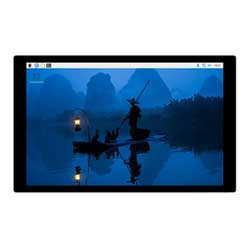- sales/support
Google Chat: zj734465502@gmail.com
- sales
+86-0755-88291180
- sales01
sales@spotpear.com
- sales02
dragon_manager@163.com
- support
tech-support@spotpear.com
- CEO-Complaints
zhoujie@spotpear.com
- sales/support
WhatsApp:13246739196
8-DSI-TOUCH-A User Guide
Features
- 8inch DSI touch screen, ten-point capacitive touch control
- IPS display panel with hardware resolution of 800×1280
- Optical bonding toughened glass panel, clearer picture quality
- Toughened glass capacitive touch panel, hardness up to 6H
- Drive the LCD through the DSI interface, with a refresh rate of up to 60Hz
- Supports software control of backlight brightness
- Aluminum alloy back cover design, pure passive cooling design
Electrical Specifications
| Parameters | Minimum Value | Standard Value | Maximum Value | Unit | Note |
| Input voltage | 4.75 | 5.00 | 5.30 | V | Note 1 |
| Input current | - | 0.8 | TBD | A | Note 2 |
| Operating temperature | 0 | 25 | 60 | ℃ | Note 3 |
| Storage temperature | -10 | 25 | 70 | ℃ | Note 3 |
•Note 1: Input voltages exceeding the maximum or improper operation may cause permanent damage to the device.
•Note 2: The input current needs to be ≥ 0.8A, otherwise it will cause the startup failure or display abnormality, and staying in an abnormal state for a long time may cause permanent damage to the device.
•Note 3: Please do not store the display panel in a high-temperature and high-humidity environment for a long time. The display panel should operate within its limits, otherwise it may be damaged.
Interfaces
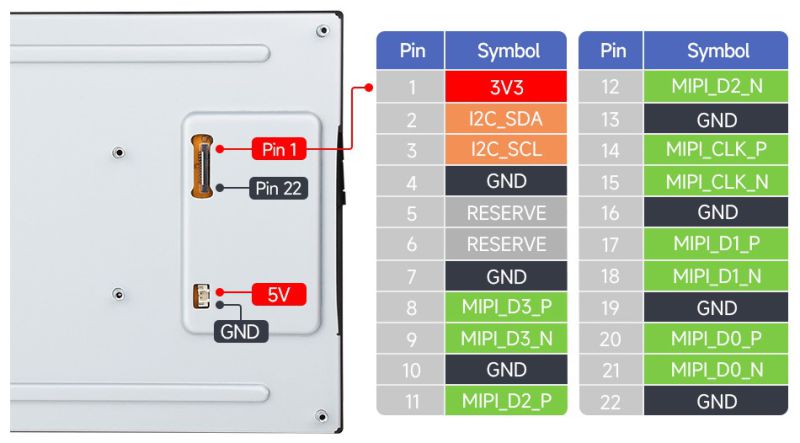
Usage Instructions
Raspberry
Pi5 Hardware Connection
1. Use the "FFC Cable 22PIN 200mm (opposite direction)" to connect the DSI port of the display to the 22PIN DSI port of the Raspberry Pi motherboard. 2. Use the "GPIO cable" to connect the power connector of the display to the 5V GND pin header of the Raspberry Pi motherboard. 3. Secure the Raspberry Pi to the display with M2.5 screws.
The installation effect is as follows: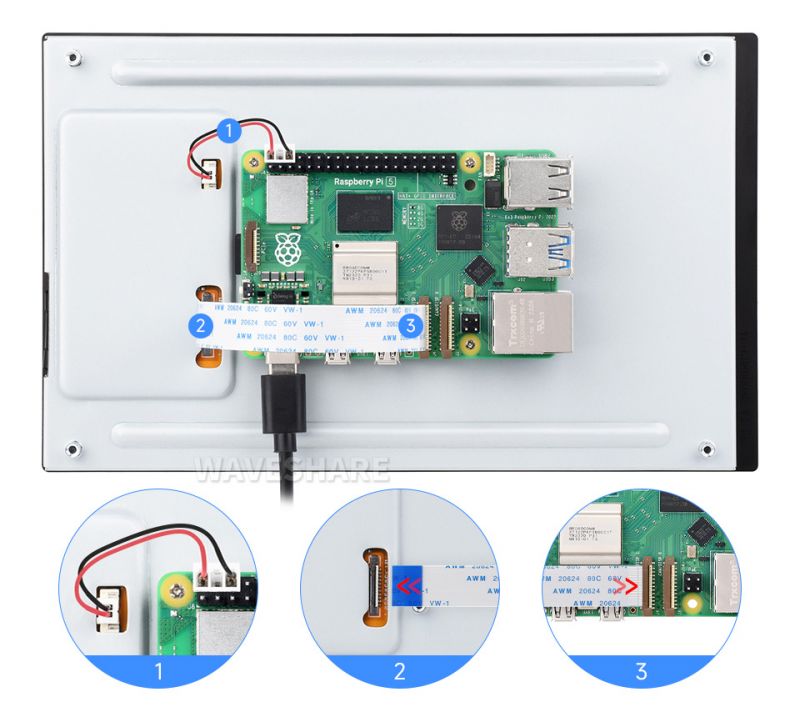
Note: Make sure that the DSI cable is connected in correct direction and 5V power is supplied through the GPIO pins.
Pi4B/3B+/3B/3A+ Hardware Connection
1. Use the "DSI-Cable-12cm" cable to connect the DSI port of the display to the 15PIN DSI port of the Raspberry Pi motherboard. 2. Use the "GPIO cable" to connect the power connector of the display to the 5V GND pin header of the Raspberry Pi motherboard. 3. Secure the Raspberry Pi to the display with M2.5 screws.
The installation effect is as follows: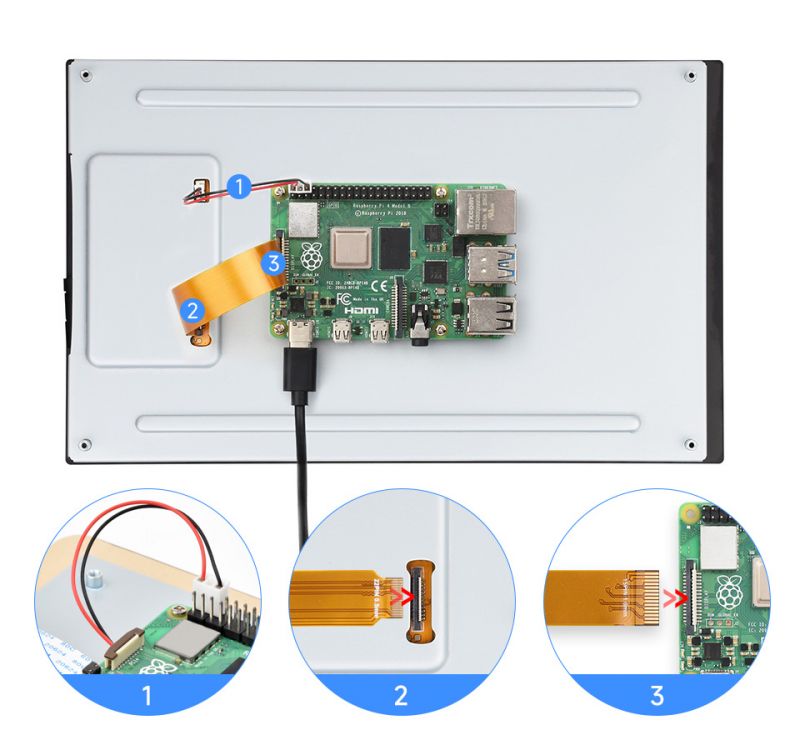
Note: Make sure that the DSI cable is connected in correct direction and 5V power is supplied through the GPIO pins.
Software Settings
Method 1: Flash the Pre-installed Image (recommended)
1. Select pre-installed image, download and unzip it as .img file
8-DSI-TOUCH-A pre-installed image
2. After the image flashing is completed, connect the TF card to the Raspberry Pi, start the Raspberry Pi, and wait for about 30 seconds for it to be displayed and touched normally.
Method 2: Install the Driver Manually
1. Connect the TF card to the PC, download and use Raspberry Pi Imager to flash the corresponding system image.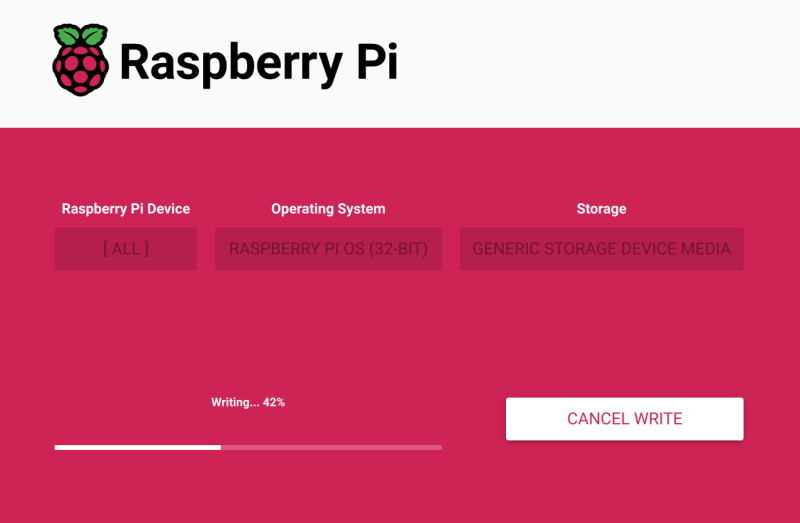
2. After the flashing is completed, connect the TF card to the Raspberry Pi, start the Raspberry Pi, and log in to the terminal of the Raspberry Pi (you can connect the Raspberry Pi to the HDMI display or use ssh to log in remotely).
3. Run the following command on the terminal to install the driver:
(This method is only suitable for 64-bit systems)
wget https://files.waveshare.com/wiki/common/Panel-waveshare-dsi2-driver.zip unzip Panel-waveshare-dsi2-driver.zip cd panel-waveshare-dsi2-driver make sudo cp ./waveshare-panel-regulator.ko /lib/modules/$(uname -r) sudo cp ./panel-waveshare-dsi-v2.ko /lib/modules/$(uname -r) sudo depmod sudo modprobe waveshare-panel-regulator sudo modprobe panel-waveshare-dsi-v2 sudo dtc -I dts -O dtb -o vc4-kms-dsi-waveshare-panel-v2.dtbo vc4-kms-dsi-waveshare-panel-v2.dts sudo cp vc4-kms-dsi-waveshare-panel-v2.dtbo /boot/overlays/
Edit config.txt file
sudo nano /boot/firmware/config.txt
Note: Since Pi5/CM4/CM3+/CM3 has two mipi DSI interfaces, please note that the correct DSI interfaces and commands are used, DSI1 is recommended by default.
Add the following code at the end of the file
dtoverlay=vc4-kms-v3d #DSI1 Use dtoverlay=vc4-kms-dsi-waveshare-panel-v2,8_0_inch_a #DSI0 Use #dtoverlay=vc4-kms-dsi-waveshare-panel-v2,8_0_inch_a,dsi0
Save and exit, restart and wait for about 30 seconds for normal display and touch to work.
Bookworm Touch Screen Rotation
- 1. Open the "Screen Configuration" application;
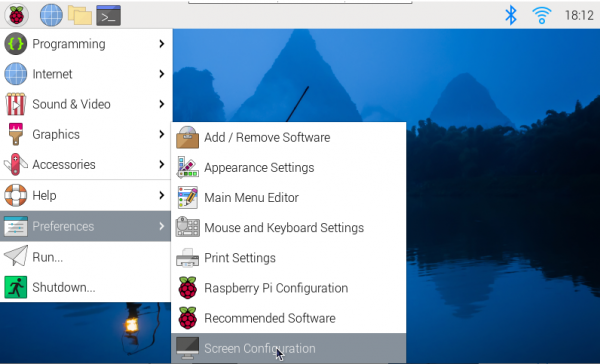
- 2. Go to Screen - > DSI-1 - > Touchscreen and check 10-0014 Goodix Capacitive TouchScreen;
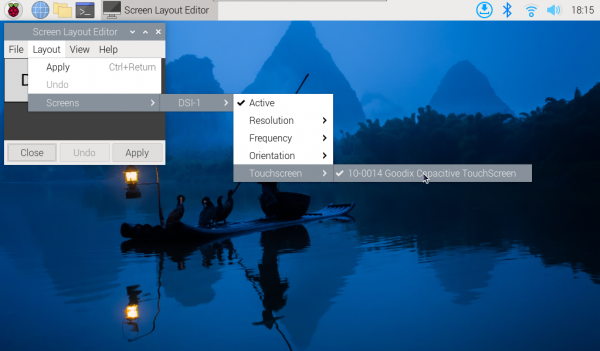
- 3.Click Apply, then close the current window, and reboot according to the pop-up prompts to complete the specified touch screen;

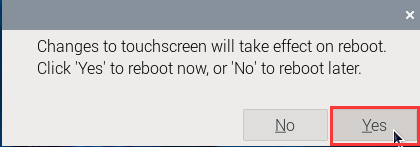
- 4.Go to Screen -> DSI-1 -> Orientation, check the direction you need to rotate, and finally click Apply to complete the display and touch synchronous rotation.

Note: Only the Bookworm system supports the above synchronization rotation method. For the Bullseye and Butser systems, manual separate settings for touch rotation are required after displaying the rotation.
lite Version Display Rotation
sudo nano /boot/firmware/cmdline.txt #Add a command to display the rotation angle at the beginning of the cmdline.txt file, and save it to take effect after restarting #Display rotation 90 degrees video=DSI-1:800x1280M@60,rotate=90 #Display rotation 180 degrees video=DSI-1:800x1280M@60,rotate=180 #Display rotation 270 degrees video=DSI-1:800x1280M@60,rotate=270
Note: If you are using Pi5/CM4, the actual recognized DSI display number will prevail, for example DSi-2.
Touch Rotation
sudo nano /etc/udev/rules.d/99-waveshare-touch.rules
#Set the command of touch rotation angle within the file, and it will take effect after the restart
#90°:
ENV{ID_INPUT_TOUCHSCREEN}=="1", ENV{LIBINPUT_CALIBRATION_MATRIX}="0 -1 1 1 0 0"
#180°:
#ENV{ID_INPUT_TOUCHSCREEN}=="1", ENV{LIBINPUT_CALIBRATION_MATRIX}="-1 0 1 0 -1 1"
#270°:
#ENV{ID_INPUT_TOUCHSCREEN}=="1", ENV{LIBINPUT_CALIBRATION_MATRIX}="0 1 0 -1 0 1"
#Save, exit, and reboot
sudo reboot
Luckfox-Omni3576
Hardware Connection
1. Use a 22PIN FPC cable to connect the DSI interface of the display to the DSI interface of the Omni3576 motherboard.
2. Use a 2PIN power cable to connect the power interface of the display to the 40PIN GPIO interface on the Omni3576 motherboard. As shown in the figure below: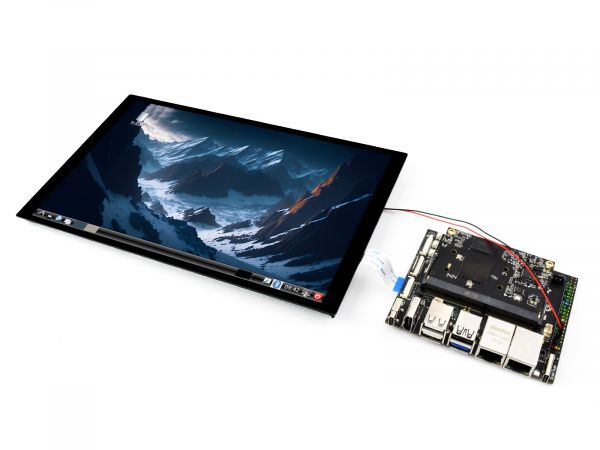
Software Settings
1. Download and use the mirror file from the Luckfox official website to flash the corresponding system image.
2. Connect the Omni3576 motherboard to a 5V power supply, and the screen will light up after the system starts
View Screen Information
- The screen ID available in the current system can be viewed using the following command:
sudo cat /sys/kernel/debug/dri/0/summary
- Under normal circumstances, the following output will be obtained:
Video Port0: DISABLED
Video Port1: ACTIVE
Connector:DSI-1 Encoder: DSI-203
bus_format[100a]: RGB888_1X24
overlay_mode[0] output_mode[0] SDR[0] color-encoding[BT.709] color-range[Full]
Display mode: 800x1280p60
clk[70000] real_clk[69883] type[48] flag[a]
H: 800 840 860 880
V: 1280 1300 1304 1324
Fixed H: 800 840 860 880
Fixed V: 1280 1300 1304 1324
Esmart1-win0: ACTIVE
win_id: 1
format: XR24 little-endian (0x34325258) pixel_blend_mode[0] glb_alpha[0xff]
color: SDR[0] color-encoding[BT.601] color-range[Limited]
rotate: xmirror: 0 ymirror: 0 rotate_90: 0 rotate_270: 0
csc: y2r[0] r2y[0] csc mode[0]
zpos: 1
src: pos[0, 0] rect[800 x 1280]
dst: pos[0, 0] rect[800 x 1280]
buf[0]: addr: 0x00000000fe44e000 pitch: 3200 offset: 0
Video Port2: DISABLED
Display Rotation
- Rotation command
#Rotate 90 degrees xrandr -o left #Rotate 270 degrees xrandr -o right #Rotate 180 degrees xrandr -o inverted #Rotate 0 degrees xrandr -o normal
- The effect of using xrandr rotation is a one-time and the screen orientation is restored after the system restarts. If you want the device to rotate automatically upon startup, you need to modify the configuration file:
sudo vim /etc/X11/xorg.conf.d/10-monitor.conf
Add the following statement:
### Valid values for rotation are "normal", "left", "right"
Section "Monitor"
# Identifier "Default Monitor"
Identifier "DSI-1"
Option "Rotate" "left"
EndSection
Touch Rotation
- After the system displays rotation, the touch direction is inconsistent, and you need to perform the following operations to touch and rotate:
sudo vim /etc/udev/rules.d/99-luckfox-touch.rules
- Add the corresponding configuration according to your rotation direction, save it, and restart the development board.
90 degrees:
ENV{ID_INPUT_TOUCHSCREEN}=="1", ENV{LIBINPUT_CALIBRATION_MATRIX}="0 -1 1 1 0 0"
180 degrees:
ENV{ID_INPUT_TOUCHSCREEN}=="1", ENV{LIBINPUT_CALIBRATION_MATRIX}="-1 0 1 0 -1 1"
270 degrees:
ENV{ID_INPUT_TOUCHSCREEN}=="1", ENV{LIBINPUT_CALIBRATION_MATRIX}="0 1 0 -1 0 1"
Luckfox-Lyra
Hardware Connection
1. Use a 22PIN FPC cable to connect the DSI interface of the display to the DSI interface of Luckfox-Lyra board.
2. Use a MX1.25 2PIN to 4PIN cable to connect the power interface of the display to the USB MX1.25 4P interface on Luckfox-Lyra board. As shown in the figure below: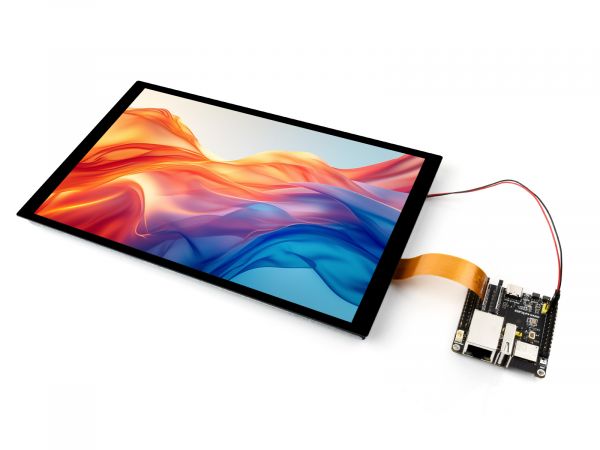
Software Settings
1. Download and use the mirror file from the Luckfox official website to flash the corresponding system image.
2. Connect the Luckfox-Lyra board to a 5V power supply, and the screen will light up after the system starts
View Screen Information
- The screen ID available in the current system can be viewed using the following command:
cat /sys/kernel/debug/dri/0/summary
- Under normal circumstances, the following output will be obtained:
VOP [ff600000.vop]: ACTIVE
Connector: DSI-1
bus_format[100a]: RGB888_1X24
overlay_mode[0] output_mode[0]color-encoding[1] color-range[1]
Display mode: 800x1280p60
dclk[70000 kHz] real_dclk[69475 kHz] aclk[294912 kHz] type[48] flag[a]
H: 800 840 860 880
V: 1280 1310 1314 1324
win1-0: ACTIVE
format: XR24 little-endian (0x34325258) SDR[0] color-encoding[0] color-range[0]
csc: y2r[0] r2r[0] r2y[0] csc mode[0]
zpos: 0
src: pos[0x0] rect[800x1280]
dst: pos[0x0] rect[800x1280]
buf[0]: addr: 0x06100000 pitch: 3200 offset: 0
post: sdr2hdr[0] hdr2sdr[0]
pre : sdr2hdr[0]
post CSC: r2y[0] y2r[0] CSC mode[2]
Display Test
- Color bar test command
#Vertical bar test modetest -M rockchip -s 74@71:800x1280 #Slant bar test modetest -M rockchip -s 74@71:800x1280 -Ftiles
Touch Test
- Touch test command
evtest
- Under normal circumstances, the following output will be obtained:
No device specified, trying to scan all of /dev/input/event* Available devices: /dev/input/event0: 2-005d Goodix Capacitive TouchScreen Select the device event number [0-0]:
- After entering "0" and pressing enter, touch the screen to start testing, and the terminal will print the event values triggered by the touch operation.
ESP32-P4
Screen Driver

The ESP32-P4-NANO drives the screen via MIPI 2-lane
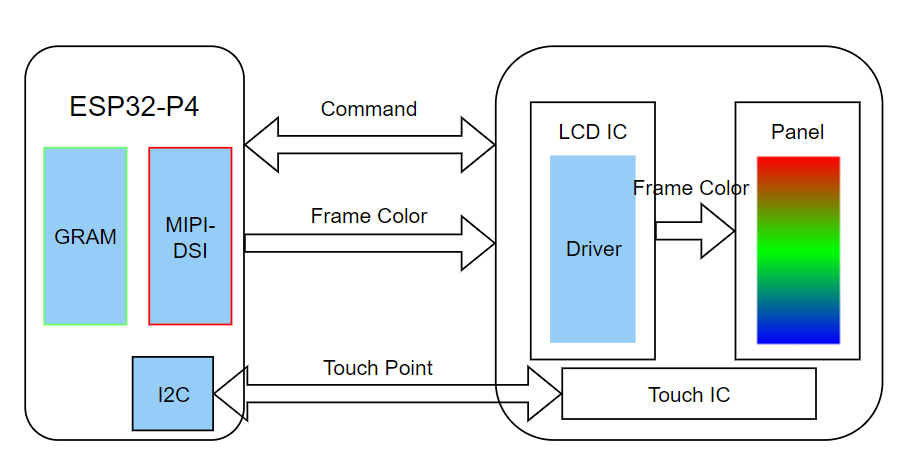
- The screen driver has been packaged as a component, with the component located at ESP Component Registry
Useidf.py add-dependency "waveshare/esp_lcd_jd9365_8"to add components to your ESP-IDF project - You can also directly view the ESP32-P4-NANO driver for this screen on the Wiki: ESP32-P4-NANO_MIPI-DSI
Backlight Control
After connecting the ESP32-P4-NANO with the matching FPC cable and power cable, the backlight can be controlled by writing 0x00~0xFF (full brightness) to the 0x45 device and 0x86 register on the screen through the ESP32-P4-NANO I2C
If you use the ESP32-P4-NANO BSP component, you can control it directly by the following functions
bsp_display_brightness_init(); // Initialize the backlight bsp_display_backlight_on(); // Turn on the backlight, default full brightness Bsp_display_backlight_off(); // Turn off the backlight bsp_display_brightness_set(95); // Set the specific backlight brightness, 0~100
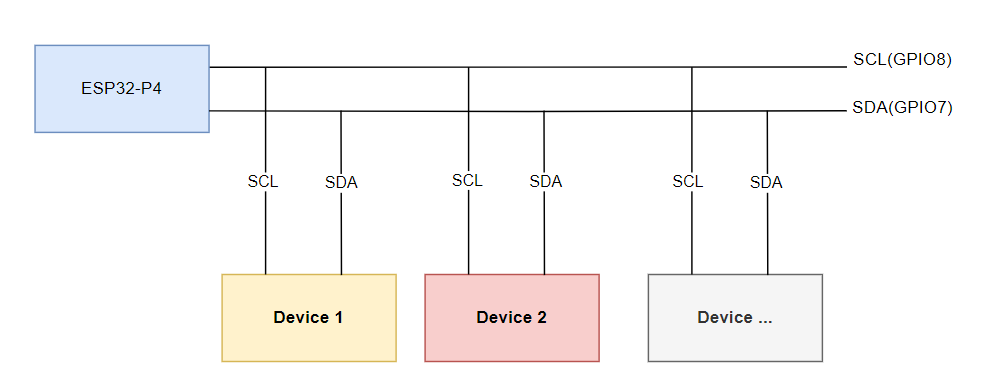
Resources
FAQ
Support
Monday-Friday (9:30-6:30) Saturday (9:30-5:30)
Email: services01@spotpear.com




